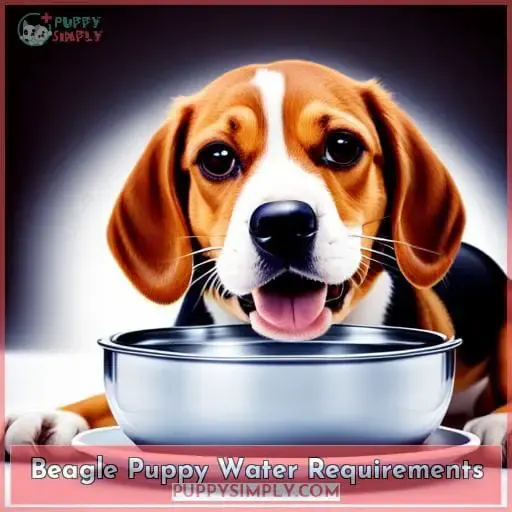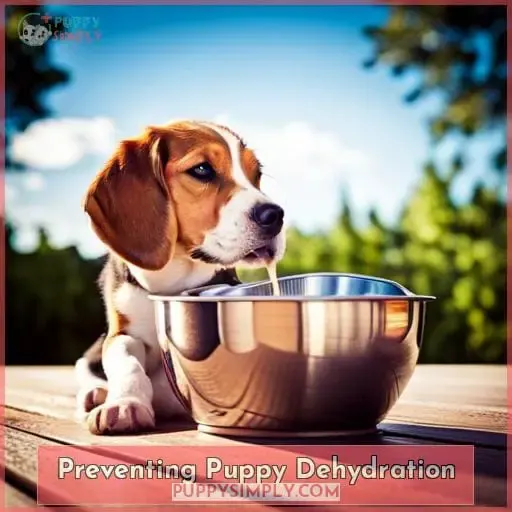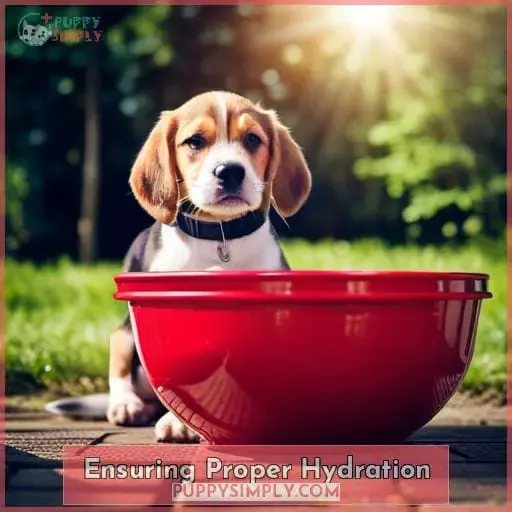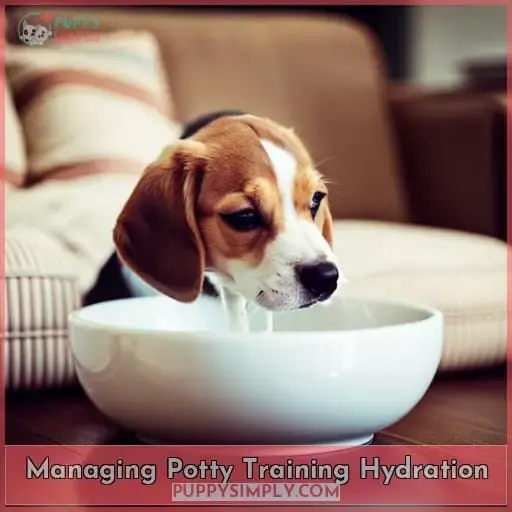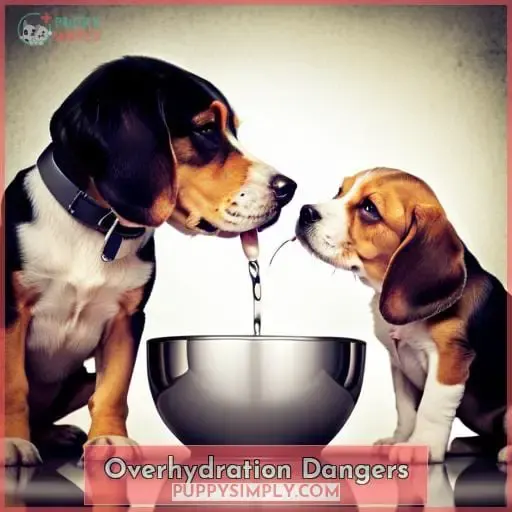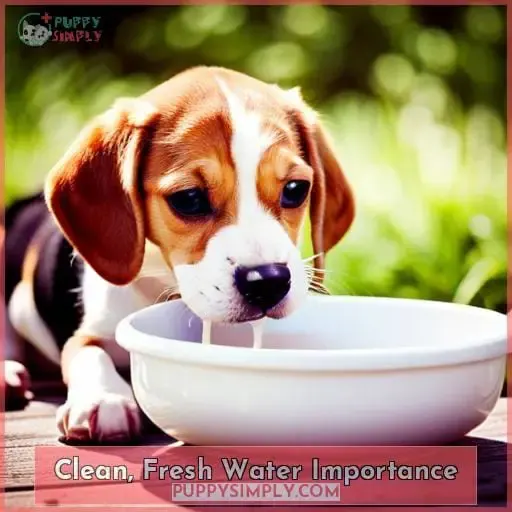This site is supported by our readers. We may earn a commission, at no cost to you, if you purchase through links.
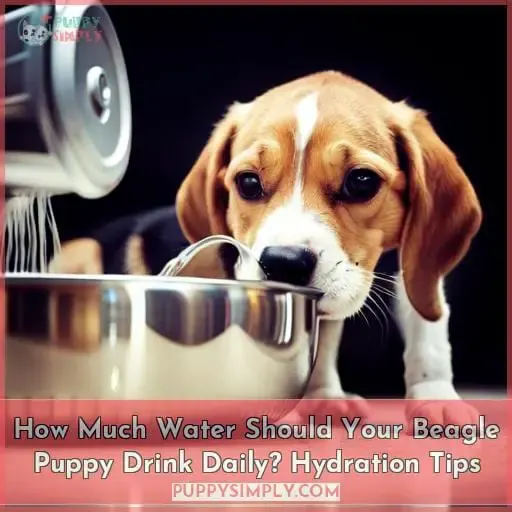 Let your Beagle’s hydration needs guide your water decisions.
Let your Beagle’s hydration needs guide your water decisions.
Understand how much is enough and too much to help your pup thrive.
Monitor intake levels, pay attention to signs of dehydration or overhydration, and ensure constant access to fresh, clean water.
Tailor offerings to age while considering climate and activity.
Carefully evaluate any changes as potential indicators for vet assessment.
Table Of Contents
- Key Takeaways
- Beagle Puppy Water Requirements
- Preventing Puppy Dehydration
- Ensuring Proper Hydration
- Recognizing Possible Health Issues
- Managing Potty Training Hydration
- Overhydration Dangers
- Clean, Fresh Water Importance
- Frequently Asked Questions (FAQs)
- How often should I refill my puppy’s water bowl during the day?
- What temperature should the water be for my puppy?
- Is it okay if my puppy likes drinking from puddles outside?
- Should I give my puppy bottled water instead of tap water?
- Is there a water filtration system you recommend for puppy drinking water?
- Conclusion
Key Takeaways
- Beagle puppies need 1-2 ounces of water per pound of body weight per day, adjusted for activity level and weather.
- Monitor your puppy’s water intake daily for concerning increases or decreases in consumption.
- Provide constant access to fresh, clean drinking water in a tip-proof bowl.
- Contact your veterinarian if you notice symptoms like bloody urine, lethargy, vomiting, or other signs of potential health issues.
Beagle Puppy Water Requirements
Depending on your puppy’s age and weight, you’ll need to provide adequate water daily to support their growing bodies.
Use the rule of thumb of 1-2 ounces per pound per day. For example, a 10 pound puppy would need 10-20 ounces of water.
Adjust for activity level and weather—more water is needed on hot or active days.
Provide fresh, clean water in a tip-resistant bowl, ideally a water fountain for filtered, flowing water.
Track daily consumption to ensure they meet water needs, watching for concerning increases or decreases that could signal illness. Consumption can fluctuate day-to-day, but significant deviations warrant a vet visit for hydration assessment and treatment.
Routine weighing helps gauge water needs as they grow. Ensuring proper hydration from these formative months sets up healthy lifelong habits.
Preventing Puppy Dehydration
Your pup’s vulnerability to dehydration requires vigilance about its water intake and health signals.
As a Beagle owner, you must monitor for concerning symptoms like diarrhea, vomiting, lethargy, and rapid weight loss, which can indicate dehydration. Additionally, watch for sunken eyes or skin that lacks elasticity when gently pulled – these are telltale visual signs.
Ensure your puppy has access to fresh, clean water at all times in a bowl that’s sized appropriately. Avoid letting your pup drink from puddles or unfiltered tap water, which can contain contaminants. Understand standard Beagle water requirements and provide the right amount of water for its age and size.
Catching dehydration early allows for prompt veterinary treatment to restore hydration before it becomes life-threatening.
Ensuring Proper Hydration
When it comes to hydration for your Beagle puppy, focus on:
- Setting up the right water bowls
- Offering water-rich foods
Use tip-proof, easy to clean bowls that are sized appropriately for your growing pup.
You can also add moisture to your puppy’s diet by incorporating foods like:
- Canned fish
- Cottage cheese
- Watermelon
- Cooked eggs
Bowl Setup Tips
Frequently place your puppy’s water bowl in an easily accessible spot to promote regular hydration.
- Use an elevated, wide, and shallow bowl to make drinking easier.
- Choose a heavy, non-tip bowl.
- Try offering small frozen cubes to peak interest.
- Consider getting a fountain with circulating water and replace filters regularly.
Offer Water-Rich Foods
You can offer your puppy some foods with high water content to help meet its hydration needs.
Try giving small pieces of watermelon, cucumber, or frozen fruit as tasty hydrating treats.
Adding some no-salt broth or plain yogurt to your pup’s kibble can also increase fluid intake.
But beware of letting your pup drink from lakes, which may contain parasites, or tap water with added fluoride.
In an emergency, Pedialyte can help stabilize hydration.
Recognizing Possible Health Issues
Occasionally your puppy drinking too much or too little water can indicate an underlying health issue.
If you notice symptoms like bloody urine, pale gums, lethargy, sunken eyes, or vomiting, it’s important to have your vet examine them right away.
Changes in hydration can signal problems like a urinary tract infection, kidney disease, diabetes or other conditions requiring prompt treatment.
Monitoring water intake daily provides a baseline to identify when something’s off.
Don’t hesitate to call your vet if you have any concerns to get their professional assessment.
They can run tests to determine if an illness is causing increased thirst or lack thereof.
Addressing potential health problems early on gives your pup the best chance at effective treatment and preventing escalation.
Your vet wants what’s best for your puppy’s health and wellbeing.
Working together, you can ensure your Beagle pup stays happy and hydrated as they grow.
Managing Potty Training Hydration
As your puppy begins potty training, closely managing water intake is key.
Give your Beagle puppy regular potty breaks—at least every two hours for young pups—to allow frequent opportunities to relieve themselves.
Limit water one to two hours before bedtime to help avoid nighttime accidents.
However, be careful not to limit daytime water, which risks dehydration and related puppy health issues.
An overly thirsty Beagle pup may drink excessively when water is made available, upsetting a delicate potty training balance.
Aim to preempt your puppy’s needs by providing fresh, clean drinking water consistently throughout the day.
Establishing a water intake routine fosters good potty training habits critical for your pup’s long-term health and happiness.
Overhydration Dangers
In rare cases, your pup could drink an excessive amount, leading to potentially serious health complications like electrolyte imbalances. Watch for signs of overhydration like lethargy, vomiting, diarrhea, loss of appetite, excessive urination, or bloating.
Overhydration is often caused by giving young pups too much water too quickly or by letting them gulp water vigorously after intense play. To prevent it, use portion-controlled bowls, offer small amounts of water periodically instead of full access, and limit water intake to a reasonable level after high activity.
Paying attention to proper daily hydration while limiting excessive intake will help keep your pup healthy.
Clean, Fresh Water Importance
Refresh your puppy’s water at least twice a day to ensure it stays clean and appealing for proper hydration.
- Use filtered water or bottled spring water to avoid tap water contaminants
- Wash food and water bowls daily with soap and hot water
- Check for and remove debris, dirt, etc.
- Replace water if it looks, smells or tastes bad
Some common water dangers for puppies:
- Puddles can contain parasites, bacteria or toxic substances
- Lake water may harbor dangerous organisms like blue-green algae
- Toilet water contains cleaners and bacteria
If your puppy drank these, offer Pedialyte to help restore fluids and electrolytes while avoiding food until the stomach settles. Ultimately, providing fresh, clean water encourages proper hydration for health.
Frequently Asked Questions (FAQs)
How often should I refill my puppy’s water bowl during the day?
You should refill your puppy’s water bowl 2-3 times per day.
Check the level morning, afternoon, and evening, refilling whenever it gets low.
Puppies need frequent access to fresh clean water for proper hydration.
Monitor consumption and refill more often if needed.
What temperature should the water be for my puppy?
The water should be cool, not cold.
Room temperature water around 70 degrees Fahrenheit is ideal, as this matches a puppy’s body temperature.
Is it okay if my puppy likes drinking from puddles outside?
No, allowing your puppy to drink from puddles is unsafe.
Puddles can contain parasites, bacteria, chemicals, or other contaminants that could make your puppy sick.
Provide fresh, clean water instead.
Monitor your puppy’s water intake and watch for signs of illness.
Should I give my puppy bottled water instead of tap water?
Tap water is fine for most puppies.
However, bottled water may be preferable if your local tap water contains high levels of contaminants or harsh chemicals.
Check with your vet or breeder if uncertain.
Ultimately focus on access, freshness and cleanliness – key for proper hydration.
Is there a water filtration system you recommend for puppy drinking water?
I would recommend a gravity-based or reverse osmosis water filtration system to improve your puppy’s drinking water quality.
These systems effectively remove contaminants while retaining healthy minerals.
Providing clean, fresh water encourages good hydration and supports your puppy’s health.
Conclusion
A pup should take in about one ounce of water per pound of body weight daily.
Ensure access to fresh, clean water at all times.
Monitor your Beagle’s water intake and watch for signs of dehydration or overhydration.
Adjust amounts for climate, activity level, and age.
Water supports all aspects of canine health, so let your puppy’s needs guide provision while addressing changes promptly.
Vet visits help verify proper hydration.

